Introduction
The concepts of integration have various definitions in the academic and political arenas based on the socio-political structures and development levels of target countries. When tension and potential conflict between refugees1 and host community members are prevalent, integration becomes a critical topic for international organizations and governmental institutions. These actors, among many others, are in search of comprehensive methods to understand problems and handle challenges between different communities. Integration-related problems are frequently analyzed and explained with reference to the ethnic, linguistic, and religious dynamics of diverse communities. Such socio-cultural dynamics, together with economic factors, are considered key factors of integration.2 Nationalist sentiments, language barriers, and intolerance of other beliefs have a great negative influence on the level of integration between refugees and host communities. However, this study aims to emphasize other dynamics that have been case-specific, with a special focus on the historical background of the refugee movement from Iraq to Syria.3
In the social sciences, specifically within the disciplines of sociology, history, and politics, experimentation is not possible. To overcome this problem, diverse case studies and comparisons are used to analyze the effects of different conditions. To study integration with specific attention to case-specific factors, this article elaborates on Iraqi refugees in Syria, who share the same language, religious, and ethnic identities with the host community in Syria. However, these common key factors are not sufficient to assure integration. Therefore, this case allows for analyzing factors other than language, religion, and ethnic differences. This article aims to provide a comprehensive description of the concept of integration as well as the prominent barriers to integration.
The article proceeds as follows: The first section discusses the concepts of integration dynamics through the terms integration, inclusion, and social cohesion. This section suggests a twofold analysis for understanding the barriers to integration: key factors and case-specific factors. The second section describes the historical background of the refugee flow from Iraq to Syria. The third section discusses which factors affected the Iraqi refugees’ decision to move to Syria. All in all, the following sections analyze the social cohesion, integration, and inclusion of Iraqi refugees in Syrian society. The article also assesses the current conditions of Iraqi refugees after the beginning of the Syrian civil war. It concludes that the Syrian government intended to seek temporary solutions to meet the major requirements of Iraqi refugees, which constituted barriers to social cohesion, inclusion, and integration of refugees.
Concepts of Integration Dynamics
Integration, Inclusion, and Social Cohesion
The terms integration, inclusion, and social cohesion are critical to the adaptation of refugees in host countries. Integration refers to the mutual adaptation process among refugees and local communities on the individual and group levels with social, political, and economic dimensions. It includes multiple responsibilities and rights for both communities, including but not limited to education, health, and the labor market.4
Nationalist sentiments, language barriers, and intolerance of other beliefs have a great negative influence on the level of integration between refugees and host communities
Some international organizations use the term social cohesion instead of integration. There is no common definition of the concept of social cohesion in the literature. According to the UNDP, there are two different dimensions of social cohesion: inequality and social exclusion. Social cohesion involves tolerance and respect for diversity (political preferences, age, religion, economic status, gender, etc.) both individually and institutionally. In societies where harmony cannot be achieved, several issues are observed, including violent crimes, violent conflicts, targeting minorities, and other human rights violations.5
The Directorate-General for Social Cohesion of the Council of Europe defines social cohesion as one of the fundamental principles that ensure everyone has fundamental rights under equal conditions. According to the Council, social cohesion is the best concept to reject all forms of exclusion and increase social awareness on this issue. This definition is similar to the UNDP’s definition of social cohesion, which considers economic integration to be part of social cohesion.6 Furthermore, a striking recognition of social cohesion, which differs slightly from the rest, is made by the International Organization for Migration (IOM). The IOM defines integration by combining ‘inclusion’ and ‘social cohesion’ under a larger umbrella. Briefly, it accepts that both inclusion and social cohesion are integral but distinct parts of integration. The distinction between these two concepts gives us a clear lens to distinguish between economic integration and political participation (termed ‘inclusion’) and socio-relational aspects of integration on the level of acceptance and belonging (termed ‘social cohesion’). In this way, the IOM’s definition of the term social cohesion distinguishes it from previous definitions of social cohesion. According to the IOM, while integration is a multifaceted concept that addresses the social, cultural, civic, economic, and legal spheres that affect the lives of migrants, social cohesion forms only a smaller part of it by focusing on social perceptions. Therefore, social cohesion refers to the prevention of discrimination and xenophobia and the spread of a culture of tolerance.7
Table 1: Elements of Integration
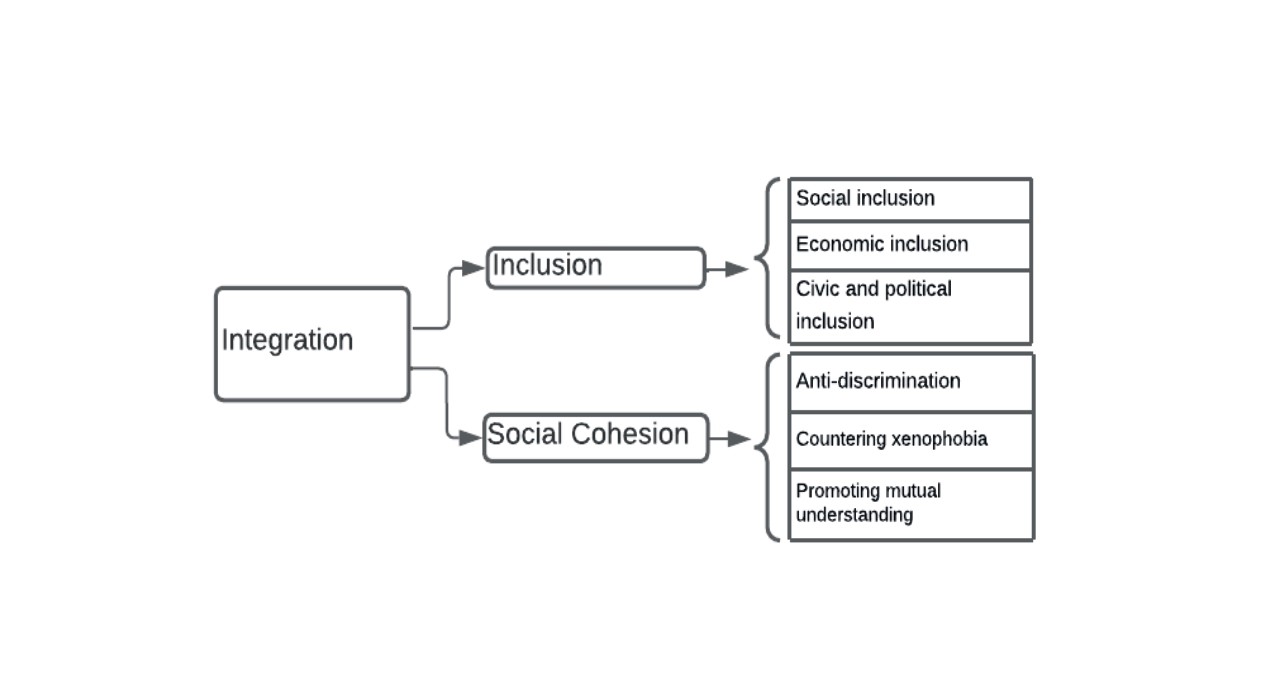
Source: International Organization for Migration8
The first pillar of integration is inclusion, as shown in Table 1, which has social, economic, civic, and political aspects. Accordingly, the first stage of inclusion is related to access to fundamental and basic services. This is a sine qua non for inclusion in the access of refugees to basic rights such as health, education, and the freedom to use their basic human rights. Identifying the obstacles to accessing basic services and developing solution proposals by governmental or civil society actors are evaluated under this concept. The concept of inclusion also refers to inclusion in economic life, meeting the needs of food and shelter, livelihood, using professional capacity and savings, and creating appropriate job opportunities with equal pay policies. In addition, instead of the periodic financial support provided by states and non-governmental organizations for refugees, economic inclusion suggests sustainable solutions for refugees by both supporting the economic development of the host country and providing their own livelihoods.
Civic and political inclusions are additional aspects of inclusion. These aspects refer to the rights of refugees to freely participate in social and political formations such as institutions, organizations, and political parties, to express their own problems and suggestions. Today, while exclusionary and discriminatory policies and discourses against refugees increase in social media and the political arena in many countries, the representation of refugees in the political arena is limited.
The second pillar of integration is social cohesion. Social cohesion is a process9 that has three dimensions: The first dimension of social cohesion is anti-discrimination, which refers to the elimination of attitudes and expressions of discrimination in society and the adaptation of a multiculturalist approach.10 Anti-discrimination is important because discrimination may affect the well-being of refugee community members negatively, which may reduce motivation and energy in the process of adapting to the host community. The second dimension of social cohesion is countering xenophobia. This dimension addresses the need for eliminating xenophobia and enhancing respect for different identities and ideas, as well as creating a sense of belonging that makes refugees feel comfortable in the host country. Acceptance and belonging are reciprocal phenomena that complement each other for a successful process of social cohesion. The third dimension is promoting mutual understanding. International actors suggest a community-based approach that enables the understanding of the concerns and prejudices of both communities, which is crucial to ensuring social cohesion.11
Today, while exclusionary and discriminatory policies and discourses against refugees increase in social media and the political arena in many countries, the representation of refugees in the political arena is limited
Integration is possible by including these two elements: inclusion and social cohesion. It is important that policymakers consider both refugees and citizens as active and productive participants in the social cohesion process and integrate this theoretical approach into the law-making process to touch upon the daily practices of both communities. This approach is adapted by intergovernmental and civil organizations. This article elaborates on the factors of integration for Iraqi refugees in Syria with regard to inclusion and social cohesion.
Barriers to Integration
Integration is a comprehensive process that can be achieved through several components. While these components have been discussed above, it is critical to be aware of some factors that prevent this process. This article has adapted a method that determines further dynamics as well as key factors and understands the relationships among the dynamics so that the social reality of integration can be understood better.12 As suggested by Dimitrov and Angelov, the main factors of integration mentioned would be insufficient to explain the social reality of specific cases. Therefore, the authors would need to identify case-specific dynamics in addition to key factors:
All these measures and tools are considered key factors for successful refugee integration. However, the measures depend on the specific country, as the socioeconomic, cultural, and political characteristics in the receiving countries are not similar and the newcomers in every single state differ in many aspects such as religion, ethnicity, etc.13
Utilizing the suggestions mentioned in the report of the Council of Europe and the article of Dimitrov and Angelov, it is aimed to understand barriers to integration regarding Iraqi refugees in Syria by breaking them into two categories: key factors and case-specific factors.
Table 2: Barriers to Integration
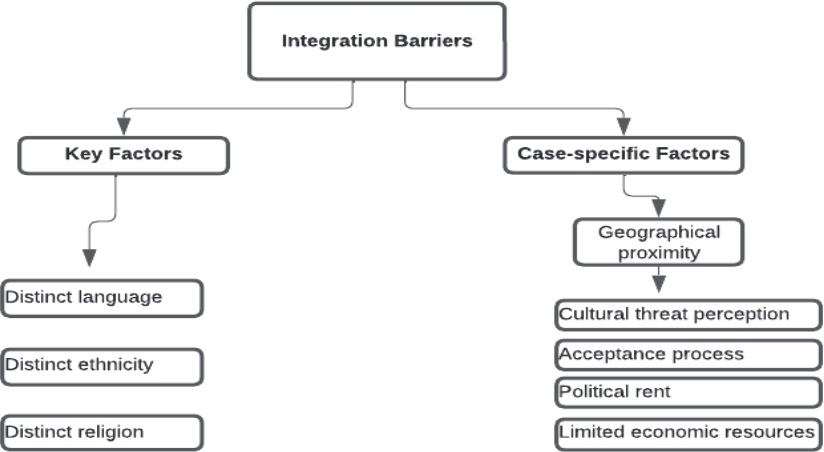
Source: Systematized and Tabulated by the Author
Table 2 illustrates a two-fold analysis of integration barriers. On the one hand, distinct language, ethnicity, and religion between the host community and refugees are conceptualized as key factors of integration.14 These three aspects are key, as the host and refugee communities share the same characteristics in the case of Iraqi refugees in Syria, which will be discussed in further pages of this paper. On the other hand, geographical proximity, acceptance processes, political rent, limited academic resources, and cultural threat perceptions are case-specific factors that act as barriers to integration.
Geographical proximity is one of the significant factors that facilitate illegal border crossings. As a result of natural or human-made disasters, refugees are forced to move out of their country and leave behind some of their properties and relatives. Geographical proximity might also facilitate a reverse effect: the return of refugees to their origin countries. This effect might emerge for two major reasons. First, it is less costly due to geographical proximity rather than integration.15 Second, adaptation problems in host countries due to physical or psychological issues might encourage refugees to return to their home countries.16 On the other hand, geographical proximity also enables rapid and permanent cross-border movement due to a common history through daily trade relations, and shared kinship ties through cross-border marriages, which collaboratively result in the formation of a social network.
Moreover, geographical proximity enables sudden and unexpected cross-border population movements and makes the acceptance process difficult for political authorities in host countries. Governments of host countries perceive this population as having temporary needs that would disappear after the crisis and expect them to return to their origin countries. Therefore, they usually do not initiate comprehensive integration programs. In addition, in countries where there is ethnic and religious diversity, this great population movement is likely to risk changing the local ethnic and religious balance. This factor is also related to the cultural threat perception that is experienced in Syria upon the arrival of the Iraqi Shia majority.17
If the officials consider the refugees outside the main agenda of their own country, they refrain from developing inclusive programming for refugees
The acceptance process is one of the major barriers to establishing a systematic integration program.18 This process depends on how political authorities define refugees. The officials might consider refugees as part of the agenda of the host or destination country, or the origin country. If the officials consider the refugees outside the main agenda of their own country, they refrain from developing inclusive programming for refugees. This problem is frequently encountered in Middle Eastern countries where internal conflicts are intense. In turn, this dynamic triggers another problem, which is political rent.
Political rent is a term that refers to political interference by politicians to gain economic, political, or social benefits.19 If the refugee issue becomes a political rent-making tool, both refugees and host communities are negatively affected. Political authorities are expected to establish support mechanisms for refugees in the bureaucracy and civil spheres, such as working opportunities in public institutions and incentives in sports and art. However, if political authorities do not support refugees sufficiently to enable them to act as actors that benefit the host country, the members of the host community perceive refugees as a burden, and this situation inevitably leads to internal conflict and human rights violations. Such political authorities may prefer to benefit from this conflict by changing their internal political agenda. In addition, the concept of “refugee rentier states” is examined to emphasize how the refugee issue is used as a foreign policy tool. According to this approach, weak states label refugee issues to seek foreign aid from the superpowers and to highlight their generous host role.20
Political leaders of host countries need to create sustainable economic policies to enrich economic resources for refugees and the host community
As a result of geographic proximity, mass migration movements might lead to the consumption of scarce economic resources. In addition, limited economic resources are a significant barrier to integration, which might emerge due to the restriction on private sector initiatives by host states in market affairs. Hence, the problem of insufficient job opportunities emerges. Political leaders of host countries need to create sustainable economic policies to enrich economic resources for refugees and the host community. Two factors should be considered during the development and implementation of these policies: an accountable system and transparency. In the absence of these factors, limited economic resources trigger political rent.
Historical Background of the Iraqi Refugee Flow to Syria
The Middle East has been engulfed in many crises due to political instability, wars, ethnic conflicts, proxy wars, and foreign interventions in the last two decades. Iraq has witnessed several catastrophic issues because of these reasons. Particularly, the Iran-Iraq War (1980-1988) and the First Gulf War (1990-1991) devastated Iraq, which was followed by the U.S. intervention in Iraq in 2003.21 The intervention resulted in the destruction of the economy and infrastructure of the country, and hundreds of thousands of people lost their lives.22 After the intervention, a new political and social order under the influence of Shias was established, which was backed by U.S.-driven agents. The suppression of the Iraqi people by the Saddam Hussein Administration and foreign intervention deteriorated the political and social stability of the country. Therefore, Iraqi people had to move out of the country to have better living conditions.23 Iraqi refugees migrated to many different countries, including the Middle East and Europe.24 However, the first resort for Iraqi refugees has been Syria due to the open-border policy for refugees.25
Table 3: Estimated Numbers of Iraqi Refugees in the Middle East
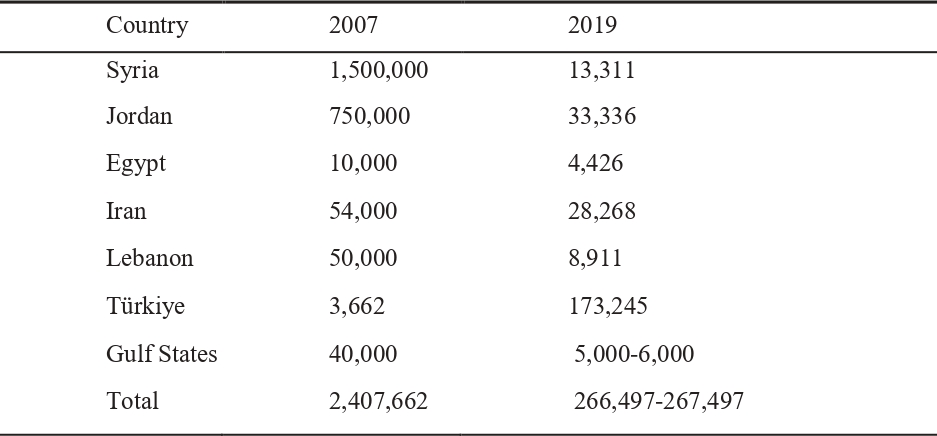
Source: UNHCR26
As Table 3 illustrates, there were an estimated one-and-a-half million Iraqi refugees who immigrated to Syria after the Iraq war.27 In addition, destinations for Iraqi refugees were not only limited to Syria and Jordan; they also moved to other Arabic countries such as Yemen, and Egypt. However, Syria was the most affected country by this refugee flow. Therefore, some Arab countries supported Iraqi migrants economically in Syria.28
The oppressive policies of the Hussein Administration caused the refugee influx of many different ethnic and religious groups, including Sunnis, Kurds, Assyrians, Shiites, Yazidis, and Sabean-Mandeans.29 Following the open-border policy of the Syrian government, civilians who exposed the political pressure of the authoritarian government and were attacked by Iraqi regime forces moved to Syria.30
Table 4: Ethnicity Category of Iraqi Refugees in Syria in 2006
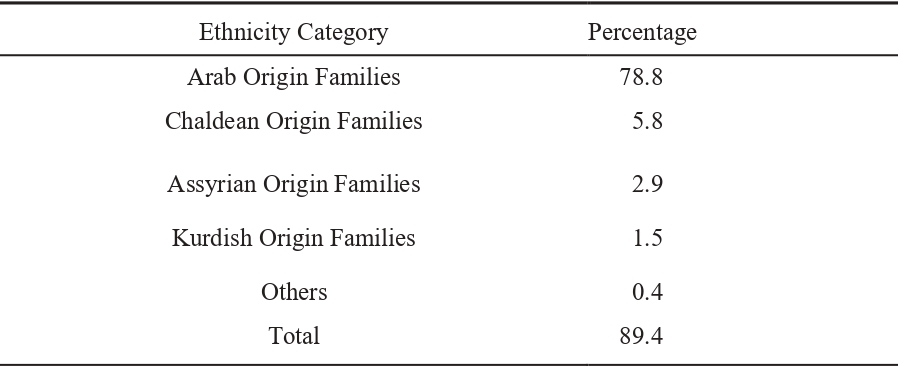
Source: UNHCR31
There is a possibility that refugees with different ethnic backgrounds might face integration problems in their host countries. Whether the Iraqi refugee flow caused integration problems in Syrian society is a critical question.
The Reasons for the Iraqi Refugees to Immigrate to Syria
There are various reasons for the Iraqi refugees to move to Syria. First, the identity-related factors (linguistic, religious, and ethnic identities) of refugees were motivating factors for Iraqi asylum seekers in Syria. For example, Shia groups that came from Iraq were supported, especially by Shia charities that received support from Iran and Iran-backed religious groups in Syria. In addition, most of the Ba’ath members and even President Assad, who is affiliated with the Shiites, advocated for these groups.32 The political situation changed after the invasion of Iraq because the Shiites in Iraq came to power, which was followed by political pressure on Sunni Muslims. Therefore, many Sunnis immigrated from Iraq to Syria as a result of the exclusionary policies, even though Shia ideology dominated the Baathist regime in Syria. In addition to these reasons, motives such as cultural and historical bounds between the two nations, and speaking the same language affected their choice.33
Syria has various sects of Islam and different religions. Sunni groups have been the majority in Syria, with approximately 75 percent. Shia groups have been about 12 percent.34 Despite this fact, the regime has been under the control of Nusayris, which did not prevent a great number of Shias from migrating from the neighboring countries to Syria.35 Table 5 illustrates the ratio of different religions and sects among Iraqi refugees in Syria, which shows the great gap between Shia and Sunni refugees.
Table 5: Religion among Iraqi Refugees in Syria in 2006
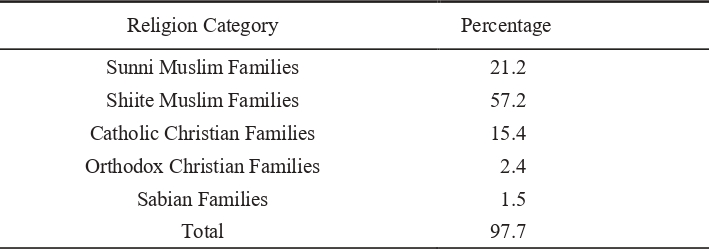
Source: UNHCR36
Second, geographical proximity played a critical role in the immigration of Iraqi refugees to Syria. It is easier to cross the border with Syria because the Iraq-Syria border is loosely controlled. In addition, the Syrian government had not implemented any restrictions and tolerated refugees by initially offering relatively better conditions. Further, daily life was inexpensive in Syria compared to other Middle Eastern countries, which influenced the decision of refugees. Social networks were also an important factor in geographical proximity. This factor affected the geographical distribution of Iraqi refugees in Syria in line with their sects and identities. Sectarian identities, social networks of trade, and kinship ties were influential aspects that motivated them to migrate to Syria. While Iraqi Sunnis usually resided in Qudsiya and Masaken Barzeh, Iraqi Christians settled in Jaramana. Most Shias predominated in Sayyida Zeyneb.37
Although Iraqi refugees in Syria share language, religion, and ethnic diversity with the host community, they have had serious difficulties accessing services due to being considered part of a temporary immigration movement
Last, despite the shared identities and existing social networks, cultural threat perception was still prevalent among the host community members, which inhibited social cohesion. Although the residential distribution of refugees was implemented in line with the religious and ethnic backgrounds in Syria, members of host communities, including Sunni and Shia people, expressed anxiety about the change in the population balance among rival religious groups and sects. This anxiety can be considered a cultural threat. An example of a cultural threat emerges among Christian and Muslim identities in European countries. However, in the context of Syria, the rival groups are religious sects and ethnic groups due to the local dynamics.38 A cultural threat was prevalent in the case of Iraqi refugees in Syria despite the existing social networks generated by geographical proximity and a shared composition of language, religious, and ethnic identities.
Social Inclusion of Iraqi Refugees in Syria
The acceptance process and political rent are two interrelated factors as barriers to integration generated by policymakers and governments. Although Iraqi refugees in Syria share language, religion, and ethnic diversity with the host community, they have had serious difficulties accessing services due to being considered part of a temporary immigration movement. The problems raised in Syria were legitimized by a developing discourse that refused to accept the long-term provision of services for refugees and was used as a tool of political rent.
In the case of large movements of refugees due to geographical proximity, governments have difficulties considering this population as permanent and providing equal status to host community members, which can be described as the acceptance process by policymakers. As Iraqi refugees did not obtain long-term permanent status, they did not have equal access to services. This deficiency in inclusion in services demonstrates that the lack of acceptance of refugees as long-term residents prevented policymakers from applying comprehensive inclusion programming, specifically in the education and health sectors. A problem emerges when the political authorities do not implement a comprehensive integration program. Lack of integration prevents refugees from becoming strong actors who provide benefits to the host states in various areas. The financial burden on the livelihood of refugees has to be met by the host government through foreign aid.
Table 6: The Age Groups of Iraqi Refugees in 2006

Source: UNHCR39
As Table 6 indicates, almost half of the Iraqi refugees in Syria (47.3 percent) were children, for whom education is an important aspect of social cohesion. As mentioned above, promoting mutual understanding was an important pillar of social cohesion, and the fact that there were diverse sects and religious communities in Syria made it necessary for the government to attach great importance to providing educational services for refugees.
Since there were many refugees under 18 without access to education, the Syrian government should have invested more in education. As Table 2 has illustrated, Syria hosted approximately one-and-a-half million refugees until 2007. Further, as Sassoon suggests, children between the ages of 5 and 15 accounted for 35 percent of this refugee number.40 According to Table 7, among these children, more than 60 percent are enrolled in school.
Table 7: Enrolment Rate of Refugee Students in Schools in 2006 (Percentage)

Source: UNHCR41
Table 7 demonstrates that the number of students enrolled in the school is low. This can be interpreted as the failure of the Syrian state to provide educational services, which might be due to insufficient economic power and institutional structure. Furthermore, in Syria, there was insufficient health infrastructure, just like in the education field. Therefore, the health sector could only survive with the help of international organizations. The Syrian Arab Red Crescent and Teaching Hospitals also spent approximately $223,000 on the health of immigrants in 2006.42 In addition, UN agencies, such as the UNHCR, supported 50 health centers and the expansion of the capacities of some of the hospitals for cancer treatments.43 The data in the education and health fields indicate that social inclusion was not successful since services were not inclusive and widespread. The deficiency in providing inclusive health and educational services can be explained by the problems faced by policymakers regarding the acceptance process. The lack of acceptance by the Syrian government and officials to identify and accept Iraqi refugees as rights holders results in a reluctance to produce inclusive programs.
Integration programming is directly related to how refugees are defined. If governments do not consider refugees as permanent residents, they are reluctant to launch inclusive integration programming. In this case, the Syrian government refrained from taking full responsibility. This was experienced in Syria, when Fayssal al-Mekdad, Deputy Foreign Minister of Syria, expressed Iraqi refugees as a problem that needed to be addressed by the Iraqi government.44 He stated that “I am ashamed to discuss Iraqi support (for the refugees). We told the Iraqi government that these nationals are Iraqis, and they are suffering real, not imaginary hardship.”45 The statement of the Syrian Deputy Foreign Minister clearly demonstrates that the Syrian government considered Iraqi refugees as temporary refugees who needed to be under Iraqi responsibility and therefore avoided initiating a comprehensive integration program. Arguably, this lack of acceptance, namely considering refugees as part of a temporary movement, also served the purpose of the government to distract the public debate from economic failures to the immigrant issue.
As long as policy plans exclude a sudden mass refugee influx, host states define the received refugees as temporary residents and seek temporary solutions to meet the fundamental needs of refugees
Political rent was also in place as another barrier to integration in Syria. In the case of Iraqi refugees in Syria, the refugee issue was addressed as a political tool in the domestic and international realms, turning it into a major crisis between the Iraqi and Syrian authorities. The reason for the disagreement between the two countries was the issue of foreign aid. The Iraqi government received $750 million from foreign countries (more than $350 million of which was provided by the U.S.) for the recovery of displaced and affected people, but only a small budget was allocated for voluntary return activities. The Syrian government criticized the Iraqi government, announcing that Syria urgently needed foreign support due to the refugee population, which was a message for global powers.46 This is in line with the concept of “refugee rentier states,” in which such states may consider refugees as a tool to demand foreign aid.
The Effect of Iraqi Refugees on Syria’s Internal Market
Limited economic resources were one of the main barriers to integration. There are two major economic factors in this regard in Syria: the government-controlled private sector and Syria’s limited industrial capacity. Syria was a developing country that was dependent on two main sectors: oil and agriculture.47
Syria accommodated many different refugee groups before the civil war. Increasing the number of refugees brought additional costs by 30 percent and raised property prices by 40 percent, as well as rental and leasing costs by 150 percent. Syria was facing another major issue simultaneously: insufficient water resources. With the influx of new refugees, the water consumption rate rose by 21 percent in Syria.48
The rate of unemployment in Syria reached 18 percent in 2006, and most of the refugees worked informally. The Syrian government did not provide work permits for them, and the official unemployment rate for Iraqi refugees was approximately 80 percent for women and 53 percent for men, according to UN agencies. While some of the Iraqi refugees were able to utilize their skills in the job market, others had to either change their professions or work in non-skilled jobs based on demands from the market or due to a lack of accreditation and certification. In some cases, the reasons were basically legal status and the accessibility of low-paying jobs. Some others who had their own businesses were able to carry their businesses from Iraq to Syria and bring their valuables and assets.49
Iraqi refugees had both negative and positive effects on the domestic market and economy. A greater number of Iraqi laborers worked for lower wages than Syrian workers. This situation contributed to a burst of cheap labor in the country’s domestic job market. In addition, refugees fostered trade relations between the two countries. They sold goods and merchandise to Iraq and brought various items to Syria. Although the amount of these cross-border trades was not clear, it was considered that they contributed to the national economy.50
Iraqi Refugees during the Civil War in Syria
The Syrian civil war has affected Iraqi refugees just like all civilians in Syria.51 Syria’s economy and social and political stability have collapsed because of the war. Refugees had to leave Syria to ensure the safety of their families. Iraqis started to move to their countries in large groups. With the escalation of the conflict in Syria, the Iraqi government prepared for the returnees and envisioned return programs. The government provided different subsidies for returning refugees. It also allocated land to accommodate returning citizens.52 According to Iraqi officials, 22,000 Iraqi citizens returned to Iraq between mid-2017 and mid-2018. For those who fled from ISIS persecution, the government placed them in the al-Hawl refugee camp in Nineveh.53 Not all Iraqi refugees have returned to their country. Some of the refugees who had financial capabilities immigrated to European countries.54 While some refugees stated that they could not return to Iraq due to financial hardship, some others were able to survive in Syria thanks to the support of local and international aid organizations.55
Table 8: Iraqi Refugees in Syria
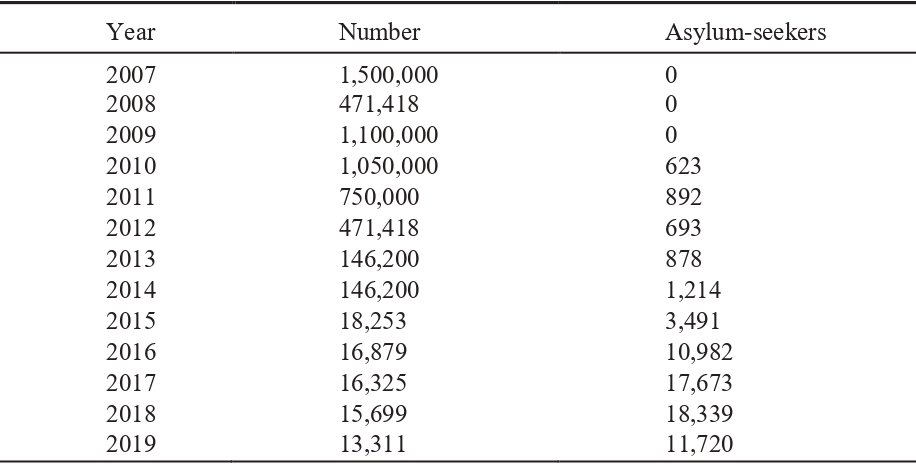
Source: UNHCR56
Table 8 illustrates that there was a dramatic decrease in the number of Iraqi refugees in Syria. Particularly, the violent conflict between opposition groups and the Baathist regime and the mortal attacks of terrorist organizations like ISIS, deteriorated the situation. Therefore, the number of Iraqi refugees decreased from 471,418 in 2012 to 18,253 in 2015.
Graph 1: Cross-border Movement to Syria by Years
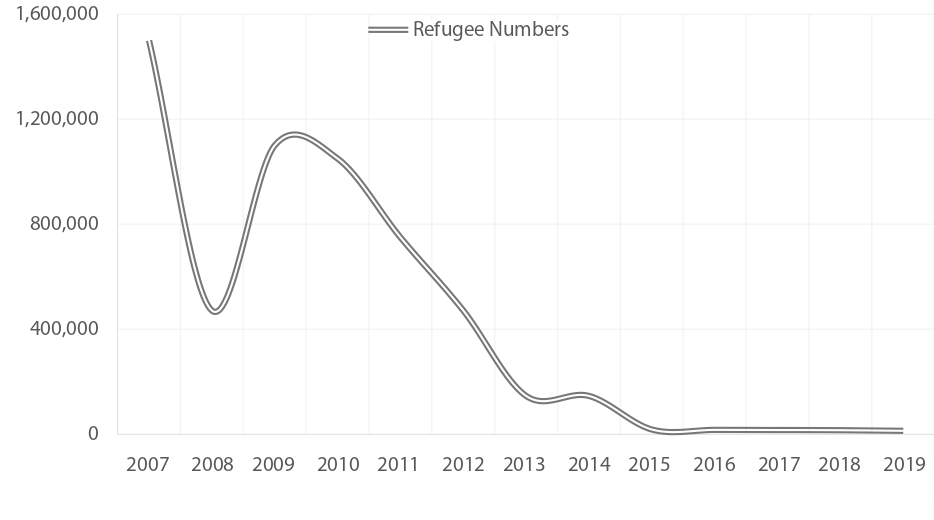
Source: UNHCR57
According to Graph 1, there have been huge fluctuations in the number of Iraqi refugees in Syria from 2007 to 2012. This fluctuation is one of the prominent dynamics that prevent comprehensive integration programs and create obstacles for policymakers. According to the UNHCR, the number of refugees returning to Iraq was about 45,000 in October 2007. The average number of refugees returning to Iraq was 1,500 in 2007, whereas the number of refugees migrating to Syria was around 500 per day. This rate changed in the following years. Some refugees who migrated to Syria believed that the security situation in Iraq had improved, and they wanted to return to Iraq to reunite with their families. In addition, the Syrian government enforced some restrictions on refugees in the following period, and in the meantime, the Iraqi government said that they would provide free onward transportation assistance to refugees who wish to return home.58
Conclusion
Iraqi and Syrian communities shared a common language, religion, and ethnicity. Despite these shared key factors, the integration of Iraqi refugees into Syrian society was quite problematic. The dispute over integration, therefore, has been the major question of this research. To answer this question, the article has suggested new integration dynamics to analyze the failure of integration. In particular, case-specific factors have played a key role in assessing this process. The case of Iraqi refugees in Syria has enabled us to focus on the effects of these case-specific factors to explain the concept of integration comprehensively.
The concept of integration suggests that if refugees are not supported by successful integration programming, they cannot build on their own resources and create a further burden on the host country for their livelihood expenses
The article found that the perceived cultural threat constitutes a barrier to integration that is influenced by local population dynamics. Since most Iraqi refugees who moved from Iraq to Syria belong to the Shiite faith, as seen in Table 5, this became a cultural threat to other groups, especially with Iran’s growing influence in Syria. The fact that unexpected refugee movement made the acceptance process difficult for the government in Syria.
This article has argued that how refugees are described is an important factor in developing integration programs, which is related to the acceptance process. As a finding of this study, as long as policy plans exclude a sudden mass refugee influx, host states define the received refugees as temporary residents and seek temporary solutions to meet the fundamental needs of refugees. In a public speech, the Deputy Foreign Minister of Syria accused the Iraqi government of not providing sufficient support to Iraqi refugees. These statements revealed that the Syrian government defended the claim that Iraqi refugees are under the responsibility of the Iraqi government. Thus, the Syrian government refused to take full responsibility. A comprehensive integration plan was not fully operational in Syria since the refugee issue was perceived as a temporary situation and the acceptance process was not completed.
Political rent, which occurs in the absence of comprehensive integration programming, has been another critical factor of integration and a result of failed integration attempts. The concept of integration suggests that if refugees are not supported by successful integration programming, they cannot build on their own resources and create a further burden on the host country for their livelihood expenses. The article has emphasized that the states, without investing in strengthening refugees in the areas of arts, sports, education, and livelihood, would need to use local resources or request foreign financial support to cover the expenses incurred because of the migrants. Both states responded to this financial burden by using the refugee issue as a tool of domestic or foreign policy in line with their interests. This process has been used as an opportunity to receive foreign aid, which is mentioned as a refugee rentier state in the literature, or to use this issue in local politics to distract the public agenda.
The sustainability of successful integration programs depends not only on policymakers but also on refugees
The lack of economic resources was discussed as a separate dynamic of integration. The Syrian political system did not allow private initiatives, and thus, the government dominated the market. Therefore, the Assad regime could not create sufficient economic resources for its own citizens and refugees. The regime attempted to resolve the refugee crisis with the support of international organizations such as UN agencies. However, it was not possible due to the ongoing civil war, which resulted in Iraqi refugees returning to their home countries gradually.
The article suggests that all the above-mentioned factors are influenced by a primary factor, which may be considered the most salient factor of integration: geographical proximity. This enables large and rapid cross-border movements in short periods during natural disasters or armed conflicts. Sudden displacements are mostly unexpected, and neighboring countries with geographical proximity are left unprepared without any integration plans or programs. Therefore, geographical proximity leads to other factors such as the acceptance process, limited economic resources, political rent, and cultural threat perception.
The sustainability of successful integration programs depends not only on policymakers but also on refugees. We can observe that the motivation of refugees to reside in these counties is crucial for the effectiveness of long-term integration plans. Refugees in host countries with geographical proximity may not have long-term plans to stay. The high circulation of refugees in the short term in Syria may have led to the fallacy of integration. It is important to note that transit (host) countries are mostly influenced in a similar way as border (host) countries with geographical proximity, and further research might focus on the distinct experiences of transit and border countries.
Endnotes
1. In this article, the term refugee refers to people who leave their country due to the fear of being harmed in relation to their religious, ethnic, or political background as defined in international law. According to legislation of Syria, the legal status of Iraqi migrant is not referred as refugees but as temporary protection status holders. For more details, please see, “Assessment on the Situation of Iraqi Refugees,” UNHCR, UNICEF, WFP, (2006).
2. Atanas Dimitrov and Goran Angelov, “Refugee Integration in the EU: Challenges and Economic Impact,” Economic Alternatives, No. 4 (2017), pp. 584-600.
3. Dimitrov and Angelov, “Refugee Integration in the EU: Challenges and Economic Impact,” p. 588.
4. “IOM and Migrant Integration,” International Organization for Migration, (2012), retrieved from https://www.iom.int/sites/g/files/tmzbdl486/files/migrated_files/What-We-Do/docs/IOM-DMM-Factsheet-LHD-Migrant-Integration.pdf, p. 1.
5. Justine Burns, George Hull, Kate Lefko-Everett, and Lindokuhle Njozela, “Defining Social Cohesion,” SALDRU Working Papers, No. 216 (2010), p. 4.
6. Jane Jenson, “Defining and Measuring Social Cohesion,” Social Policies in Small States, No. 1 (2010),
4.
7. “Integration and Social Cohesion: Key Elements for Reaping the Benefits of Migration,” International Organization for Migration, (2017), retrieved from https://www.iom.int/sites/g/files/tmzbdl486/files/our_work/ODG/GCM/IOM-Thematic-Paper-Integration-and-Social-Cohesion.pdf.
8. “Integration and Social Cohesion: Key Elements for Reaping the Benefits of Migration,” International Organization for Migration.
9. Jane Jensen, Mapping Social Cohesion: The State of Canadian Research, (Ottawa: Canadian Policy Research Networks Inc, 1998), p. 1.
10. Jeffrey G. Reitz, Raymond Breton, Karen K. Dion, Kenneth L. Dion, Mai B. Phan, and Rupa Banerjee, Multiculturalism and Social Cohesion: Potentials and Challenges of Diversity, (Canada: Springer, 2009), p. 2.
11. “4th Edition of the UNHCR Emergency Handbook,” United Nations High Commissioner for Refugees, (2018), retrieved from https://emergency.unhcr.org/about.
12. “Measurement and Indicators of Integration,” Council of Europe, (1997), retrieved from https://www.coe.int/t/dg3/migration/archives/documentation/Series_Community_Relations/Measurement_indica-tors_integration_en.pdf, pp. 32-38.
13. Dimitrov and Angelov, “Refugee Integration in the EU: Challenges and Economic Impact,” p. 588.
14. Dimitrov and Angelov, “Refugee Integration in the EU: Challenges and Economic Impact,” p. 588.
15. Ashraf al-Khalidi, Sophia Hoffmann, and Victor Tanner, “Iraqi Refugees in the Syrian Arab Republic: A Field Based Snapshot,” The Brookings Institution, (June 11, 2007), retrieved from https://www.brookings.edu/research/iraqi-refugees-in-the-syrian-arab-republic-a-field-based-snapshot/, p. 1.
16. See, Khalidi, Hoffmann, and Tanner, “Iraqi Refugees in the Syrian Arab Republic: A Field-Based Snapshot.” They specified the role of geographical proximity in the case of Iraqi refugees in Syria, building on their identification, this article argues that geographical proximity deserves bigger attention, because it has an impact such as on irregular movements, and the decision of policy makers.
17. Michael A. Zarate, Berenice Garcia, Azenett A. Garza, and Robert T. Hitlan, “Cultural Threat and Perceived Realistic Group Conflict as Dual Predictors of Prejudice,” Journal of Experimental Social Psychology, Vol. 40, No. 1 (January 2004), pp. 99-105.
18. See, Miroslav Macura, Alphonse L. MacDonald, and Werner Haug, “The New Demographic Regime: Population Challenges and Policy Responses,” UN Economic Commission and UNFPA for Europe, (2005), which mentions the acceptance process descriptively. However, this article analyses this dynamic as a result of geographical proximity and enlarges its scope.
19. Stefan Sekowski, “The Pros and Cons of Rent-Seeking: Political Rent in Various Research Paradigms,” Studia z Polityki Publicznej, Vol. 8, No. 2 (July 2021), pp. 14-24.
20. Nicholas R. Micinski, “Threats, Deportability and Aid: The Politics of Refugee Rentier States and Regional Stability,” Security Dialogue, (August 26, 2021), pp. 1-19.
21. Benjamin R. Banta, “Just War Theory and the 2003 Iraq War Forced Displacement,” Journal of Refugee Studies, Vol. 21, No. 3 (2008), p. 273.
22. Jeffrey W. Meiser, Lydia Heye, and Kelsie McKeeand, “From Anarchy to Civil War: The Escalation of Violence in Iraq, 2003-2006,” Special Operations Journal, Vol. 4, No. 1 (May 25, 2018), p. 10.
23. “A Look at the Reality of Refugees and Displaced People in the Middle East,” The New Humanitarian, (June 6, 2016), retrieved from https://www.thenewhumanitarian.org.
24. Salomé Phillmann and Nathalie Stiennon, “A Report on Joint Resettlement in the European Union,” International Catholic Migration Commission, (May 2010); Libby Effeney, “Iraqis Exiled in Australia since 2003,” Australian Journal of Political Science, Vol. 49, No. 4 (2014), pp. 662-676.
25. Mohamed Kamel Dorai, “Iraqi Refugees in Syria,” The American University in Cairo, (October 2008),
4.
26. The data is retrieved January 20, 2021, from https://www.unhcr.org/data.html, and systematically brought together by the authors.
27. “Jordan and Syria Are Facing the Iraqi Refugee Crisis without Support,” ch, (July 9, 2007), retrieved from https://www.swissinfo.ch/ara.
28. “Number of Iraqi Refugees Exceeds Announced Figures,” net, (October 2, 2007), retrieved from https://www.aljazeera.net/news/2007/10/2.
29. David Romano, “Whose House Is This Anyway? IDP and Refugee Return in Post-Saddam Iraq,” Journal of Refugee Studies, Vol. 18, No. 4 (December 2005), pp. 430-453.
30. Khalidi, et al., “Iraqi Refugees in the Syrian Arab Republic: A Field Based Snapshot,” p. 1.
31. “Assessment on the Situation of Iraqi Refugees in Syria,” UNHCR, UNICEF, (March 2006), retrieved from https://documents.wfp.org/stellent/groups/public/documents/ena/wfp119686.pdf.
32. Joseph Sassoon, The Iraqi Refugees: The New Crisis in the Middle East, (London-Newyork: I.B.Tauris & Co Ltd, 2009), p. 63.
33. Khalidi, et al., “Iraqi Refugees in the Syrian Arab Republic: A Field Based Snapshot,” p. 1.
34. Zuhdi Jasser, “Sectarian Conflict in Syria: Syria Supplemental,” Institute for National Strategic Security, (2014), pp. 58-67.
35. Jasser, “Sectarian Conflict in Syria: Syria Supplemental,” p. 61.
36. “Assessment on the Situation of Iraqi Refugees in Syria.”
37. Tahir Zaman, Islamic Traditions of Refuge in the Crises of Iraq and Syria, (Palgrave & Macmillan, 2016), p. 113.
38. Khalidi, et al., “Iraqi Refugees in the Syrian Arab Republic: A Field Based Snapshot.”
39. “Assessment on the Situation of Iraqi Refugees in Syria,” United Nations High Commissioner for Refugees.
40. Sassoon, The Iraqi Refugees: The New Crisis in the Middle East, 69.
41. “Assessment on the Situation of Iraqi Refugees in Syria.”
42. Faisal el-Miqdad, “Iraqi Refugees in Syria,” FMR Iraq Special Issues, (2007), p. 19.
43. Patricia Weiss Fagen, “Iraqi Refugees: Seeking Stability in Syria and Jordan,” Institute for the Study of International Migration, (August 1, 2009), retrieved from https://repository.library.georgetown.edu/bitstream/handle/10822/558297/CIRSOccasionalPaper1PatriciaFagen20-09.pdf;sequence=5, p. 24.
44. The Iraqi government had invited the refugees to return their country but, only a small budget consisted of a few million was allocated for this.
45. Khaled Yacoub Oweis, “Syria Says Iraq Evading Responsibility to Refugees,” Reuters, (January 18, 2010), retrieved from https://www.reuters.com/article/idUSLDE60H1GQ.
46. Oweis, “Syria Says Iraq Evading Responsibility to Refugees.”
47. Sassoon, The Iraqi Refugees: The New Crisis in the Middle East, 75.
48. Miqdad, “Iraqi Refugees in Syria,” p. 19.
49. Khalidi, et al., “Iraqi Refugees in the Syrian Arab Republic: A Field Based Snapshot,” p. 41.
50. Khalidi, et al., “Iraqi Refugees in the Syrian Arab Republic: A Field Based Snapshot,” p. 47.
51. İbrahim Aytaç Kadıoğlu, “International Peace Efforts in the Syrian Civil War: The ‘Inevitable’ Failure?” Turkish Journal of Middle Eastern Studies, Vol. 7, 1 (2020), pp. 13-44.
52. “Violence in Syria Is Forcing Iraqi Refugees to Return to Their Country,” DW, (August 3, 2011), retrieved from https://www.dw.com/ar.
53. Naza Mohamed, “000 Refugees Return to Iraq from Syria,” Anadolu Agency, (March 21, 2018), retrieved from https://www.aa.com.tr/en/middle-east/27-000-refugees-return-to-iraq-from-syria-turkey/1095350.
54. “Drastic Rise in Iraqi Refugees Returning Home,” BBC, (May 18, 2016), retrieved from https://www.bbc.com/news/av/world-middle-east-36319343.
55. Sirwan Kajjo and Zana Omar, “Iraqi Refugees in Syria Refuse to Return Home,” Voa News, (November 1, 2018), retrieved from https://www.voanews.com/extremism-watch/iraqi-refugees-syria-refuse-return-home.
56. The data is retrieved January 20, 2021, from https://www.unhcr.org/data.html, and systematically brought together by the authors.
57. The data is retrieved January 20, 2021, from https://www.unhcr.org/data.html, and systematically brought together by the authors.
58. “Iraq-Syria: The Number of Iraqis Leaving Syria more than the Number of Arrivals,” The New Humanitarian, (2007), retrieved from https://www.thenewhumanitarian.org/ar/report/457/.


